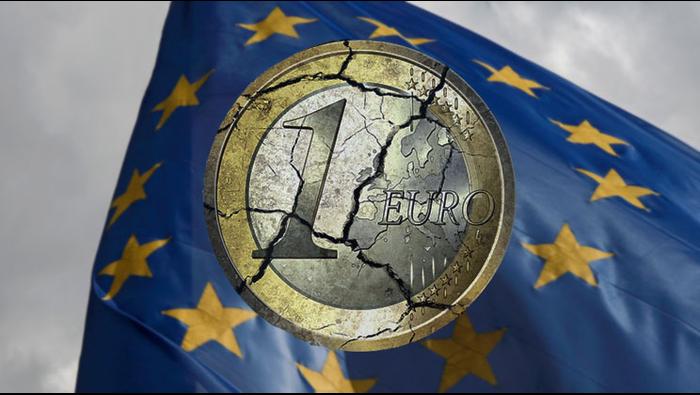Euro Forecast Overview:
- The Euro has been out of the spotlight at the start of the year thanks to the US-China trade war Phase 1 deal, US-Iranian geopolitical tensions, the Brexit deadline, and now, the Chinese coronavirus.
- Eurozone economic data has been greatly improved in recent weeks, suggesting that the ECB may not need to ease further over the coming months.
- Per the IG Client Sentiment Index, EUR/JPY and EUR/USD have mixed trading outlooks.



Euro Treading Water Through January
The Euro has had a modestly positive start to January. Attention remains away from the Eurozone thanks to shifts in key macro themes, namely the US-China trade war Phase 1 deal, US-Iranian geopolitical tensions, the Brexit deadline, and now the Chinese coronavirus. The Euro has gained ground against four currencies while losing ground against three thus far. EUR/USD is the worst performing pair, down by -1.08%, while EUR/AUD and EUR/NZD are leading the way higher, up by 1.35% and 0.97%, respectively.
Eurozone Economic Data Continues to Improve
Exogenous influences aside, Euro strength at the start of 2020 has come in hand with an ongoing improvement in domestic Eurozone economic conditions. Eurozone economic data has improved in the past few weeks, at least when trying to measure releases relative to expectations. The Citi Economic Surprise Index for the Eurozone, a gauge of economic data momentum, currently sits at 45.1 today relative to 25.5 one-month ago on December 24 and -55.9 on October 17.
Eurozone Inflation Expectations Nudging Higher
The Eurozone is faced with a situation where low growth and inflation expectations are keeping the ECB’s bias pointed towards easing. Yet new ECB President Christine Lagarde has pledged that the January meeting will commence the ECB’s formal policy review, which will provide a new course of policymakers have unanimity was broken by outgoing President Mario Draghi.
Eurozone Inflation Expectations versus Brent Oil Prices: Daily Timeframe (January 2019 to January 2020) (Chart 1)

The relationship between Eurozone 5y5y inflation swap forwards and Brent oil prices has been realigning since the start of Q4’19. The current 50-day correlation between Eurozone inflation expectations and Brent oil prices has increased from 0.46 on October 1 to 0.67 today. Weakness in short-term correlations (5-day, 20-day) have been exacerbated by the sharp pullback in energy prices amid deescalating US-Iranian geopolitical tensions.
ECB Review Period Keeps Rate Cuts at Bay
The January ECB meeting scheduled for later this week may largely come and go without much fanfare. After all, the ECB has entered 2020 in a holding period, thanks to new ECB President Lagarde using the early months of her tenure to find consensus within the Governing Council. Prior unanimity among policymakers waslost after former ECB President Draghi forced his easing package into policy at the September ECB meeting.
European Central Bank Interest Rate Expectations (January 21, 2020) (Table 1)
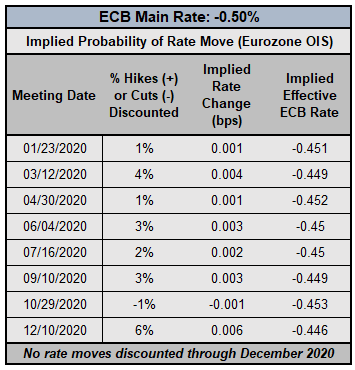
As policymakers search for a new consensus, it seems likely that the ECB will remain on the sidelines through much of 2020 – or at least until the ECB’s policy review concludes. Two key issues are at hand: first, will the ECB follow Sweden’s Riksbank and end its negative interest rate policy; and two, will the ECB change its inflation target after missing its goal every year since 2013.
According to Eurozone overnight index swaps, traders are convinced that the period of recalibration by new ECB President Lagarde will take a very long time: there is only a 6% chance of a rate move through December 2020.
EURUSD Rate versus COT Net Non-Commercial Positioning: Daily Timeframe (September 2018 to September 2019) (Chart 2)
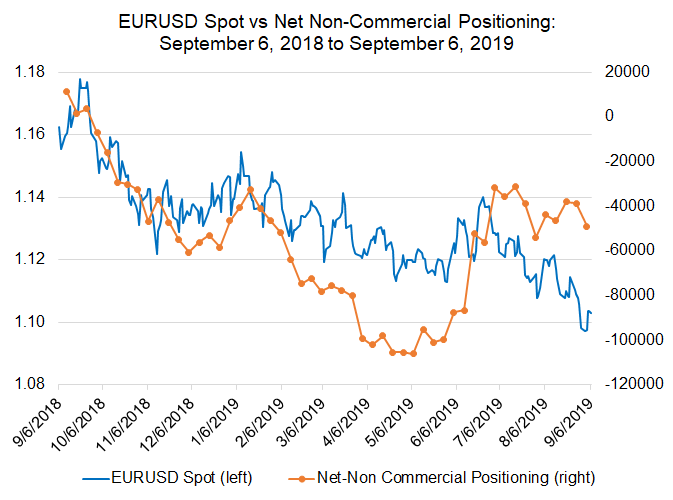
Looking at positioning (admittedly stale; the reporting period for the next week ends at market close today), according to the CFTC’s COT report for the week ended January 14, speculators decreased their net-short Euro positions from 60.7K to 48.2K contracts. Further weakness in EUR/USD rates since the January 14 reporting period closed suggests that traders should be on alert for another build in net-short positioning when the next update is released on Friday, January 24.
EUR/USD RATE TECHNICAL ANALYSIS: DAILY CHART (January 2019 to January 2020 INTRADAY) (CHART 3)
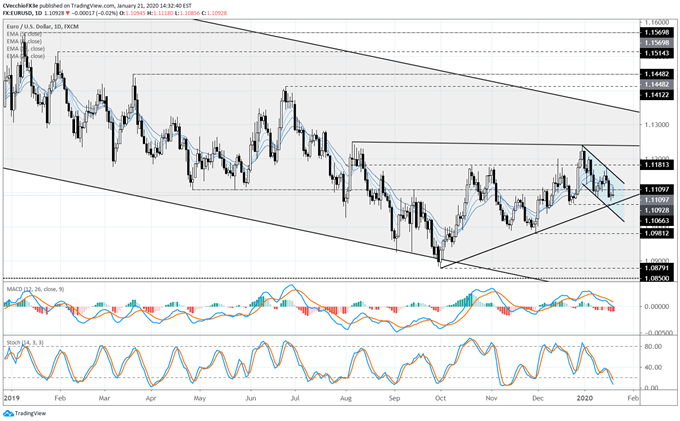
EUR/USD rates remain in a broad ascending triangle dating back to August 2019, encompassed in a broader downtrend in place since May 2018. Accordingly, the outlook is appropriately neutral for longer-term traders.
For shorter-term traders, there may be opportunities within the ascending triangle – but more clarity is needed. EUR/USD rates are intermeshed within the daily 8-, 13-, and 21-EMA envelope and a daily candle is forming a bearish outside engulfing bar. Daily MACD is dangerously close to crossing below its signal line into bearish territory, and Slow Stochastics have fallen into oversold territory; momentum is tracking to the downside.
A break below the mid-December swing low at 1.1093 would constitute a break of the uptrend from the October and November swing lows as well. In trading below 1.1093, EUR/USD’s near-term bias would switch from neutral to bearish.
IG Client Sentiment Index: EUR/USD Rate Forecast (January 21, 2020) (Chart 4)

EUR/USD: Retail trader data shows 59.34% of traders are net-long with the ratio of traders long to short at 1.46 to 1. The number of traders net-long is 0.23% lower than yesterday and 4.64% higher from last week, while the number of traders net-short is 7.82% lower than yesterday and 1.56% higher from last week.
We typically take a contrarian view to crowd sentiment, and the fact traders are net-long suggests EUR/USD prices may continue to fall.
Traders are further net-long than yesterday and last week, and the combination of current sentiment and recent changes gives us a stronger EUR/USD-bearish contrarian trading bias.
EUR/JPY RATE TECHNICAL ANALYSIS: DAILY CHART (January 2019 to January 2020 INTRADAY) (CHART 5)
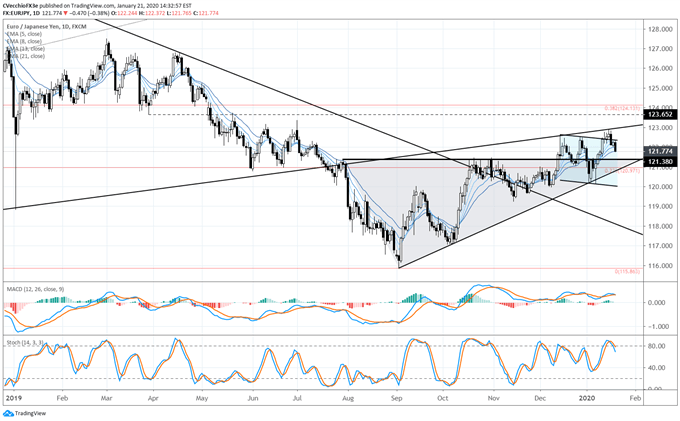
EUR/JPY rates have been an impressive advance outside of the ascending triangle in place between August and early-December, carving out a bull flag upon the breakout. But now EUR/JPY rates have run into a key form of resistance, the rising trendline going back to the 2012, 2016, and 2019 swing lows. EUR/JPY rates are clearly at an important crossroads having fallen back into the bull flag that formed between mid-December and early-January.
At present time, bullish momentum has started to wane. EUR/JPY rates are falling below their daily 5, 8-, 13-, and 21-EMA envelope, which remains in bullish sequential order; a clear sign of a sharp change in momentum from bullish towards bearish. Daily MACD has issued a sell signal (albeit in bullish territory), while Slow Stochastics have lost the overbought condition. A significant top may be forming.
IG Client Sentiment Index: EUR/JPY Rate Forecast (January 21, 2020) (Chart 6)
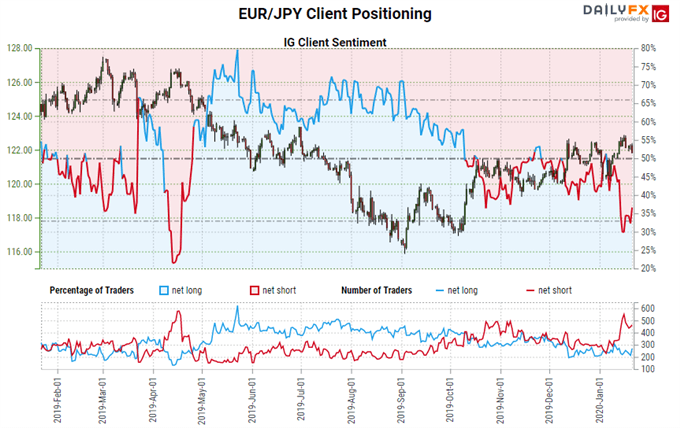
EUR/JPY: Retail trader data shows 34.59% of traders are net-long with the ratio of traders short to long at 1.89 to 1. The number of traders net-long is 7.36% lower than yesterday and 9.63% higher from last week, while the number of traders net-short is 9.96% lower than yesterday and 16.61% lower from last week.
We typically take a contrarian view to crowd sentiment, and the fact traders are net-short suggests EUR/JPY prices may continue to rise.
Yet traders are less net-short than yesterday and compared with last week. Recent changes in sentiment warn that the current EUR/JPY price trend may soon reverse lower despite the fact traders remain net-short.
--- Written by Christopher Vecchio, CFA, Senior Currency Strategist
Follow him in the DailyFX Real Time News feed and Twitter at @CVecchioFX



